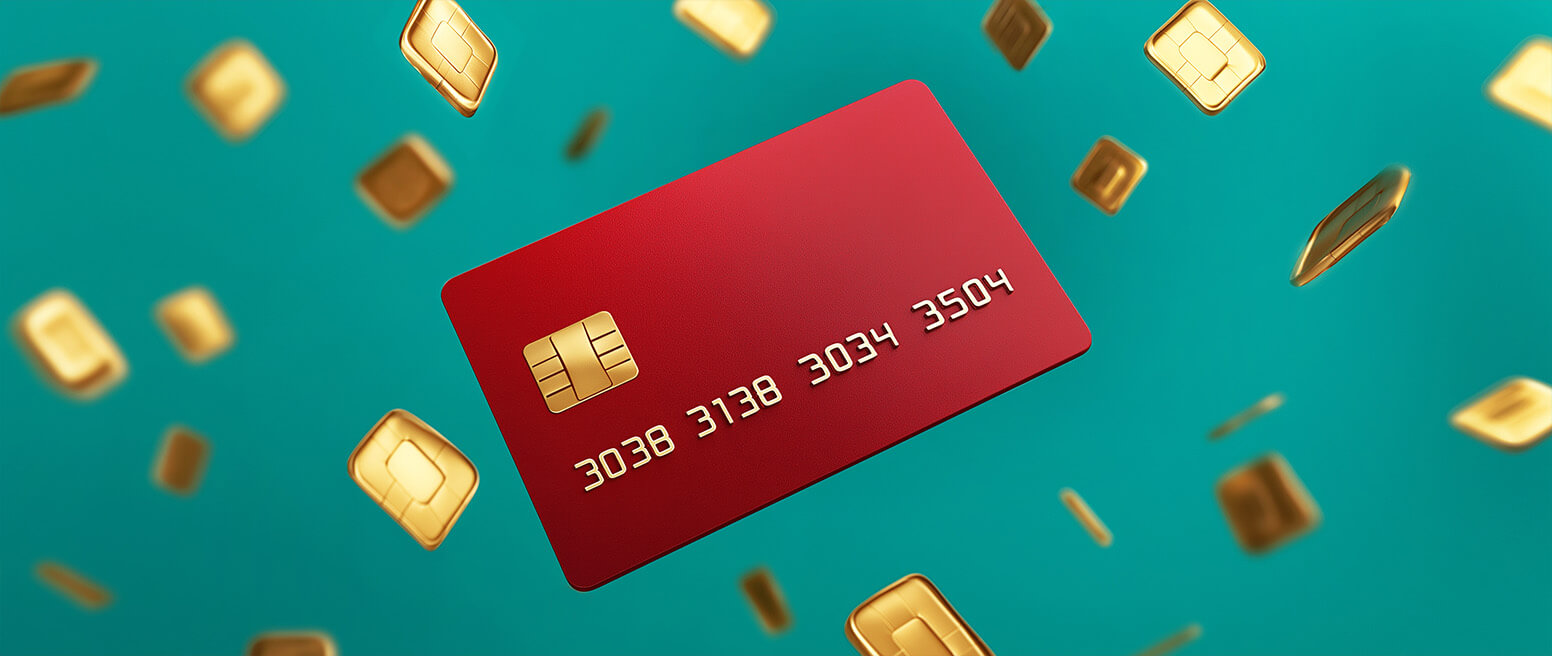What is EMV Technology? Definition, Uses, Examples, & More
In the 1990s, three global card networks — EuroPay, Visa, and Mastercard — convened to develop a suite of microchip-based payment technologies. The aim of the new standard, known as “EMV” technology, was to replace magnetic stripe technology, which was then the dominant way information was stored on payment cards.
Magstripe technology was more convenient than old-school card imprinters. But, it had a major security flaw: they encoded static information, which meant that card data could easily be duplicated by bad actors and used for unauthorized purchases.
Three decades on, and EMV chip-based cards have successfully replaced magstripe cards as the most common way to relay payment information. According to EMVCo, the global organization that manages the technical standard, 70.4% of cards issued today use EMV chips, including 90.9% in the United States.
Recommended reading
- What is EMV Bypass Cloning? Are Chip Cards Still Secure?
- Dispute Apple Pay Transaction: How Does The Process Work?
- Terminal ID Number (TID): What is it? What Does it Do?
- Visa Installments: How it Works, Benefits, & Implementation
- dCVV2: How do Cards With Dynamic CVV Codes Work?
- Electronic Funds Transfers: How EFTs Work & Examples
What is EMV?
- EMV
“EMV,” an acronym that stands for “EuroPay, Mastercard, and Visa,” refers to a technical standard for smart chip-based debit and credit cards. It also commonly refers to chip-enabled cards that use this technology.
[noun]/ē • em • vē/
EMV chip cards contain a small, metallic microchip on the front of the card that encodes encrypted details about the payment method, like the card number and expiration date.
Unlike magnetic stripe technology, which stores card details as static values, EMV chips generate dynamic, single-use transaction codes. This makes it harder for fraudsters to steal sensitive card data by cloning the microchip, which helps prevent card-present fraud.
EMV Technology vs. Magnetic Stripe: What’s the Difference?
In practice, the key difference between EMV and magnetic stripe technology is who bears liability for fraud. Before 2015, issuers were held responsible for card-present fraud. Now, though, some liability falls on merchants:
Who is Liable for Card-Present Fraud
This has resulted in a substantial decline in card-present fraud. 2025 data from the Federal Reserve Bank of Kansas City reveals that, as a result of both EMV technology and the more recent EMV liability shift in 2015, “card-present fraud loss rates for both issuers and merchants have declined for single-message networks.”
Other key points of comparison between EMV and magstripe include:
| Security Feature | EMV Chip | Magnetic Stripe |
| Data Storage | Dynamic data generated per transaction | Static data, the same every time |
| Encryption | Encrypted transaction data | No encryption |
| Authentication | Cardholder verification supported (PIN, signature, contactless) | Often relies on signature only |
| Fraud Resistance | High resistance to cloning and skimming | Vulnerable to cloning/skimming |
| Transaction Security | Unique cryptogram per transaction | Predictable, reusable data |
| Global Adoption | Widely adopted in fraud-prone environments (e.g., EU, Canada) | Phasing out in many countries |
| Liability Shift (Post-EMV Rollout) | Liability for fraud shifts to merchants if EMV is not supported | Higher fraud liability for merchants and issuers |
| Offline Capability | Can perform offline authentication securely | Relies entirely on network verification |
| Data Tampering | Tamper-resistant chip with secure element | Easily altered if physical access is gained |
How EMV Technology Works
At the heart of EMV technology are metallic microchips, which store payment details in an encrypted fashion.
To pay with an EMV card, a cardholder inserts their payment method into an EMV-enabled chip reader. Once the card comes into contact with a reader, the buyer may be asked to enter a PIN or draw a signature to prove that they are the legitimate cardholder.
If the cardholder completes the authentication challenge successfully, the chip transmits a one-time code (called a cryptogram or payment token) that is relayed by the payment terminal to the cardholder’s issuing bank via the merchant’s payment processor.
How EMV Technology Works
- EMV card is inserted into the terminal (or tapped for contactless payment).
- Terminal sends a challenge to the chip card.
- Chip card responds with cryptogram.
- When prompted, cardholder enters PIN or signature.
- Terminal packages encrypted transaction data and transmits to issuer.
- Issuer checks cryptogram’s validity against expected value.
- Issuer transmits approval response back to processor.
- Merchant receives approval response and completes transaction.
EMV technology can stop fraud... but not all fraud.
Take the first step today to get end-to-end protection against fraud attacks.
Request a Demo
The use of a dynamic cryptogram makes EMV technology more secure than the magnetic stripe technology it sought to replace. While magstripes transmit actual card information to the issuer directly, an EMV chip’s use of one-time code obscures the cardholder’s real details, protecting them from falling into the hands of bad actors.
The dynamic nature of the payment tokens relayed by chip cards is also an intentional security feature. Because each code is different, fraudsters who manage to intercept one token cannot reuse it in subsequent transactions. This contains the damage that unauthorized users can do via card-present fraud tactics like EMV chip shimming.
Benefits of EMV
EMV-enabled cards are now the global standard for good reason: they come with compelling benefits for both merchants and cardholders. Merchants who accept EMV cards can stand to gain via:
EMV Compliance & Requirements for Merchants
For merchants, becoming EMV compliant means accepting transactions using EMV-compatible payment terminals. In practice, this means that sellers will need to decommission their legacy, magstripe-only terminals, and upgrade to EMV-compliant hardware and software (if they haven’t already done so).
Merchants can take the following steps to help ensure compliance:
Because of the EMV liability shift, merchants who use non-EMV-compliant, magstripe-only terminals are liable for all fraudulent card-present transactions involving an EMV card.
Common EMV Implementation Challenges
Supporting EMV chip cards has its benefits. But, we’ll also be the first to admit that EMV implementation is not painless. Challenges include:
The Future of EMV & Payment Security
EMV will soon go from becoming the dominant standard to being the only supported payment technology.
For instance, Mastercard says that the “magnetic stripe will start to disappear in 2024 from Mastercard payment cards in regions, such as Europe, where chip cards are already widely used. Banks in the US will no longer be required to issue chip cards with a magnetic stripe, starting in 2027.”
By 2029, Mastercard will no longer feature cards with magnetic stripe globally, and by 2033, the magstripe will be phased out entirely.
Visa, meanwhile, plans to eliminate magnetic stripe cards in the United States 2027. The card network similarly expects to make magstipes fully obsolete worldwide by 2033.
This gives merchants, at the time of this writing, just a few years to start to support EMV-enabled payments, if they haven’t already done so.
Of course, the card security landscape is far from static. New technologies like biometric payments, which are already a staple of mobile wallet technology, may continue to gain traction as hardware like palm and iris scanners allow cardholders to authenticate in-person transactions using inherence factors. Payment tokens, which underlies EMV technology, may also find use cases in adjacent domains, such as ticketing, real-time payments, subscription billing, investments, and more.
Curious about how EMV technology or the EMV liability shift could impact your exposure to post-transaction fraud? Get in touch with our experts for a free, no-obligation chargeback analysis today.
FAQs
What is the meaning of EMV?
EMV stands for Europay, Mastercard, and Visa. The acronym refers to the three payment card networks that developed the smart chip-based payment technology, which improves transaction security during payment processing.
How do I know if my card is EMV?
To confirm if your card is EMV, look for a small metallic chip on the front of the card. Also, pay attention to how you pay. If you’re asked to insert, rather than swipe, your card at a payment terminal, then your card is likely EMV chip-enabled.
Do debit cards have EMV?
Yes, most debit cards issued in the last several years have had EMV chips embedded in them to minimize the risk of fraudulent and unauthorized transactions.
How do I enable EMV?
To enable EMV payments, reach out to your payment processor and ask about upgrading to a payment terminal that accepts EMV chip cards, or update your terminal software to a version that accepts EMV payments.
Is my credit card RFID or EMV?
To know whether your credit card uses RFID or EMV, look for a metallic chip on the front of your card (EMV) or a logo similar to a Wi-Fi symbol on the front or back of your card (RFID). Many cards may contain both EMV and RFID technology.
Can someone scan your credit card in your wallet?
Yes. At a close enough range, a scammer can scan your credit card using RFID technology to obtain its card number, even if you have your card hidden in your wallet. However, this type of RFID skimming is not as common as many people think.














